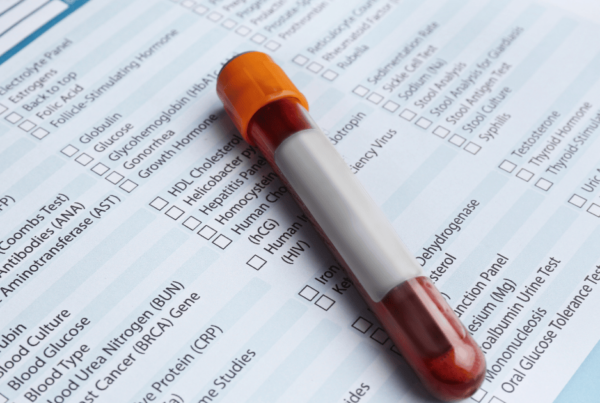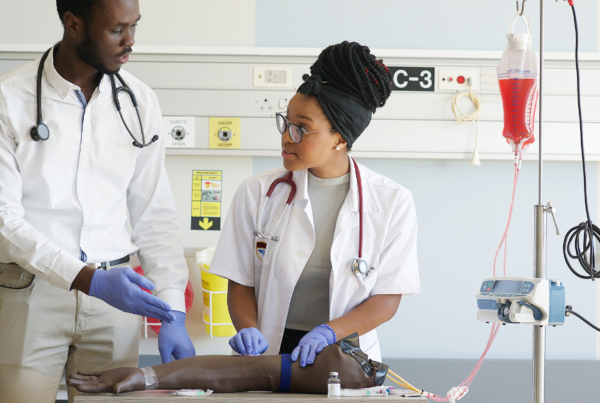The world of phlebotomy revolves around precision, efficiency, and maintaining a sterile environment. A phlebotomist’s toolkit contains a variety of devices, each of which is essential for effective blood draws and other treatments. Among these instruments, the hypodermic needle stands out as a cornerstone. But for those new to phlebotomy, the question arises: what is a hypodermic needle exactly, and how does it function within this specialized field?
This comprehensive guide delves into the world of hypodermic needles, exploring their design, purpose, different types, and their crucial role in phlebotomy practices. By understanding these vital tools, aspiring phlebotomists can gain a strong foundation for their training and future careers.
| Key Takeaways |
| Hypodermic needles are thin, hollow tubes with a sharp tip used for injections and blood draws. |
| They are a vital tool in phlebotomy, enabling procedures like venipuncture, IV therapy, and various injections. |
| Different types of hypodermic needles exist, each suited for specific applications based on size, gauge, and design features. |
| Selecting the right needle depends on factors like injection site, medication viscosity, and patient characteristics. |
| Safe handling practices are crucial, including maintaining sterility and proper disposal in sharps containers. |
What is a Hypodermic Needle?
A hypodermic needle is a very thin, hollow tube with a sharp tip, categorized as a medical sharp. It is most usually used in conjunction with a syringe, which is a hand-held instrument with a plunger. This dynamic duo allows for the injection of various substances (e.g., saline solution, medications, liquid medicines) into the body or the extraction of fluids (e.g., blood) from the body.
The History of the Hypodermic Needle
The invention of the hypodermic needle marked a significant advancement in medical practices. While the concept of injecting substances into the body existed for centuries, it wasn’t until the mid-1800s that a practical and widely used design emerged. The hypodermic needle is often credited to Scottish doctor Charles Hunter. In 1853, he invented a device combining a hollow needle and a syringe. This invention revolutionized drug delivery. It enabled faster, more precise administration than oral intake or suppositories.
The Anatomy of a Hypodermic Needle
A hypodermic needle is composed of three basic parts:
- Hub: This plastic component, typically made of polypropylene, connects to the syringe and provides a secure grip for handling. The hub size varies according to the syringe it is meant for.
- Cannula: The core of the needle, the cannula is a hollow, thin tube usually crafted from stainless steel or Niobium. Manufacturing techniques like tube drawing involve shaping the metal into a precise needle form. The tip of the cannula is sharpened to a fine point, facilitating smooth penetration during injections or blood draws.
- Cap: Made from plastic materials like polypropylene, the cap serves a crucial purpose. It protects the cannula from contamination before use and after disposal.
The Importance of Hypodermic Needles in Phlebotomy
Hypodermic needles are instrumental in various phlebotomy procedures. Here’s a closer look at their significance:
- Blood Draws: Venipuncture, the process of drawing blood from a vein, is a fundamental phlebotomy skill. Hypodermic needles facilitate this process by enabling a smooth puncture of the vein wall, allowing for efficient blood collection.
- Intravenous (IV) Therapy: In some cases, medications or fluids need to be delivered directly into the bloodstream for faster absorption. Hypodermic needles are used for IV therapy, allowing for the safe and controlled injection of these substances into a vein.
- Subcutaneous Injections: Certain medications require slower absorption into the bloodstream. Hypodermic needles are used for subcutaneous injections, where medication is delivered into the fatty tissue beneath the skin. Diabetics, for example, may receive insulin injections.
- Intramuscular Injections: For medications needing absorption at a moderate rate, intramuscular injections are performed. These drugs are delivered into muscles via hypodermic needles.
Exploring Different Types of Hypodermic Needles
Hypodermic needles come in various configurations, each suited for specific applications. Understanding these variations empowers phlebotomists to choose the most appropriate needle for each procedure. Below is a summary of the most prevalent types:
- Intravenous (IV) Needles: Designed for injections directly into a vein, IV needles are typically larger in size (20-25 gauge) to accommodate blood flow. They often have a bevel (angled tip) to facilitate easier penetration of the vein wall. IV needles come in various lengths to suit different vein depths and patient anatomy. Some IV needles may also have features like wings on either side of the injection site for better stabilization during insertion, particularly useful for patients with small veins or those who may be anxious.
- Subcutaneous Needles: These needles are smaller in size (25-30 gauge) compared to IV needles. This is because they are intended for injecting medication into the subcutaneous tissue, which is less dense than a vein. The smaller gauge allows for easier penetration and reduces discomfort for the patient. Subcutaneous needles are typically shorter than IV needles as well, as they don’t need to reach as deep into the body.
- Intramuscular (IM) Needles: Falling between the size of IV and subcutaneous needles (20-29 gauge), IM needles are used for injecting medication into muscle tissue. The right size depends on the drug and the patient’s muscle mass.IM needles are typically longer than subcutaneous needles to ensure they reach the muscle layer.
- Butterfly Needles: These needles have a unique design featuring short wings on either side of the injection site. The wings provide stability during blood draws or injections, especially helpful for patients with small veins or those who may be prone to movement. Butterfly needles are often used with a winged infusion set for short-term IV therapy. The needle size of a butterfly needle typically falls within the range of 21-25 gauge.
Choosing the Right Hypodermic Needle for the Job
Selecting the most suitable hypodermic needle for a phlebotomy procedure hinges on several factors:
- Injection Site: Different injection sites have varying tissue thicknesses. For instance, an IV needle wouldn’t be suitable for a subcutaneous injection due to its larger size. Understanding the target tissue for the injection or blood draw is crucial for choosing the appropriate needle gauge and length.
- Medication or Fluid: The viscosity (thickness) of the medication or fluid being injected influences needle size. Thicker fluids may require a larger gauge needle for easier flow through the cannula. You can inject thinner fluids with a smaller gauge needle.
- Patient Factors: Considerations include age, vein size, and body mass. Use smaller needles for kids or patients with fragile veins. They cause less discomfort and bruising. Conversely, larger needles may be necessary for patients with larger veins or those requiring the rapid administration of fluids.
Safe Practices with Hypodermic Needles
Hypodermic needles are single-use medical devices. Never reuse a needle, as it can significantly increase the risk of infection for both the patient and the healthcare professional. Here are some additional safety practices to remember:
- Sterility: Maintain a sterile environment throughout the procedure. Utilize sterile technique when handling the needle and avoid touching the bevel or cannula with bare hands.
- Disposal: Always dispose of used needles in designated sharps containers. These containers are puncture-resistant and prevent accidental injuries from needle sticks. You should never dispose of needles in conventional garbage or recycling bins.
- Training: Proper training is essential for safe and effective phlebotomy practices. This includes comprehensive instruction on needle handling, injection techniques, and safe disposal procedures. Phlebotomy Now School offers training programs that equip students with the necessary skills and knowledge to handle hypodermic needles safely and efficiently.
FAQs
Can I reuse a hypodermic needle?
Absolutely not. Hypodermic needles are single-use medical devices. Reusing a needle increases the risk of infection for both the patient and the healthcare professional.
What are the different types of hypodermic needles?
Common types include intravenous (IV) needles, subcutaneous needles, intramuscular (IM) needles, and butterfly needles. Each type is for a specific purpose. Size, gauge, and features like wings for stability form the basis.
What factors influence the choice of a hypodermic needle?
Needle selection depends on three factors. They are the injection site, the medication or fluid, and the patient. Here’s a breakdown:
- Injection Site: As mentioned earlier, different injection sites have varying tissue densities. For example, a subcutaneous injection targeting fatty tissue beneath the skin wouldn’t require a large IV needle designed for a vein. Conversely, a blood draw from a vein would necessitate a larger IV needle to accommodate blood flow.
- Medication or Fluid: The viscosity (thickness) of the medication or fluid plays a role. Thicker medications may require a larger gauge needle (lower number) to ensure smooth flow through the cannula. Thinner fluids can inject using a smaller gauge needle, in contrast.
- Patient Factors: Age, vein size, and body mass are all important considerations. Use smaller needles for kids or patients with fragile veins. They cause less discomfort and bruising. On the other hand, larger needles may be necessary for patients with larger veins or those requiring rapid administration of fluids.
Conclusion
Hypodermic needles are a cornerstone of phlebotomy, enabling a wide range of procedures from blood draws to injections. Understanding their different types, applications, and safe handling practices empowers phlebotomists to deliver quality patient care with precision and efficiency. By mastering the use of these essential tools, aspiring phlebotomists can embark on a rewarding career in this vital field of healthcare.
Phlebotomy Now School aims to provide phlebotomy training. It will set students up for success. Our curriculum emphasizes not only technical skills but also safety protocols and patient care best practices. If you want a career in phlebotomy, please explore our programs. It’s the first step to a fulfilling future.
Ready to Start Your Phlebotomy Journey?
Enroll at Phlebotomy Now School today! Gain the skills, knowledge, and hands-on experience needed to excel in the field of phlebotomy.


